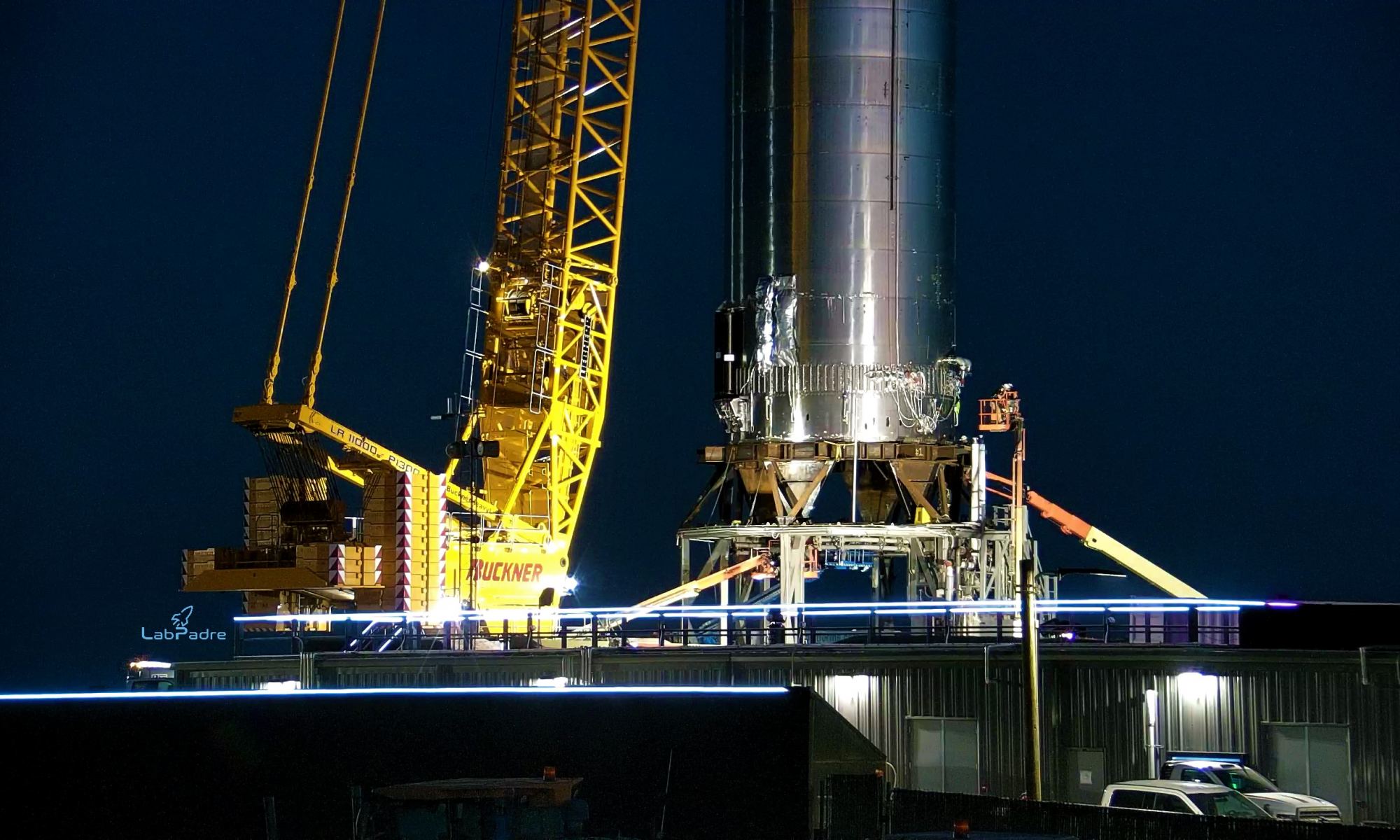As usual, the SpaceX South Texas Launch Facility, located near the village of Boca Chica, is the focal point of a lot of attention. Almost two months ago, crews at the facility began working on the first true Super Heavy prototype, the launch stage of SpaceX’s Starship. After six weeks of assembly, SpaceX rolled the Super Heavy Booster 3 (B3) out of the “High Bay” (where it was assembled) and installed it onto the launch pad.
The assembly process began on May 15th, which was assisted by the new Bridge Crane (added to the High Bay back in March) and wrapped up on Thursday, July 1st. The B3 was then moved out and loaded aboard the companies Self-Propelled Modular Transporter (SPMT) and transported down Highway 4 to the launch facility, where it was transferred by another crane onto Test Pad A.
Once it is ready to conduct commercial missions, the Starship and Super Heavy will be the world’s first entirely reusable launch system. As the booster element (aka. first stage) of the system, the Super Heavy stands about 65 meters (215 ft) tall and will be equipped with 32 Raptor engines. This record number of engines (more than any rocket in history) will allow the Super Heavy to produce 72 meganewtons (MN), or 16 million pounds/thrust (lbf).
This is more than twice the thrust generated by the first stage of the Saturn V booster, which NASA used to send the Apollo astronauts to the Moon – 35.1 MN, or 7.89 million lbf. When paired with the Starship – the orbital vehicle element that will rely on 6 Raptors engines – the launch system will be capable of sending 100 metric tons (110 US tons) to Low Earth Orbit (LEO).
According to a statement made by Musk via Twitter, the B3 prototype will be used for ground tests, similar to the ground tests conducted with the Starship (SN) prototypes. This differentiates it from Booster 1 (BN1), the first Super Heavy prototype to complete stacking inside the High Bay, which Musk explained was a “manufacturing pathfinder” designed to validate the process used to build them, and was therefore scrapped after.
B3 is the next step in the process and is designed to validate the structural design of the booster through ground testing. Musk indicated that SpaceX will be making the first flight test with Booster 4 and to expect an “especially rapid evolution in [the] first ~10 boosters and ~30 ships.” This hints that SpaceX will be maintaining its rapid-prototyping approach where design changes are incorporated between iterations.
In the same message, Musk tweeted that the B3 was “very hard to build.” All told, the assembly process consisted of stacking and welding 36 steel rings with three tank domes and dozens of other major components. Luckily, the ground crews have developed considerable expertise since the booster element is built out of many of the same parts as the Starship and the assembly process relied heavily on the same production apparatus.
The booster element is also simpler than the Starship prototypes in many ways since it does not require a heat shield, has simpler electronics and plumbing, more basic fins (not included on the B3), and two main tanks to accommodate its supply of liquid methane (CH4) and liquid oxygen (LOX) fuel. The Starship, in contrast, requires two additional header tanks in addition to its main ones and must switch to the header tanks when landing.
When it comes to flight testing, the booster prototypes only need to launch and then descend, where they will be “caught” by the . According to Musk, these prototypes (B4 and after) will be equipped with grid fins to control their descent, and the booster will reignite some of its engines to make a soft landing. To date, all high-altitude flight tests involving the Starship prototypes included the “belly-flop” maneuver, beginning with the prototype turning sidewise after reaching apogee.
It would then use its aerodynamic flaps to slow its descent and reignite one or two Raptor engines to reorient itself before landing. This complicated maneuver caused the first four prototypes (SN8, SN9, SN10, and SN11) to explode before, during, or shortly after landing. The most recent test, involving the SN15 prototype, was a complete success that validated the crucial systems and maneuvers it performed.

In any case, now that the B3 is situated on the test platform, tests can begin (possibly this week). Similar to the Starship’s development process, this will likely begin with cryogenic pressure tests, where the fuel tanks are filled with nitrogen to ensure they can withstand being filled with cryogenic methane and oxygen. This may be followed by engine integration and static fire tests.
These tests will pave the way for B4, which is currently undergoing assembly and will be integrated with the SN20 Starship prototype and prepared for orbital testing. These will then be moved to the OLS, which has also spent the past few weeks being built at the Boca Chica launch facility. It is from here that the full-stack Starship and Super Heavy will launch from when making their first orbital test flight – which could happen later this year.
In the meantime, be sure to watch the rollout of B3 onto the testing pad, courtesy of NASA Spaceflight:
Further Reading: Teslarati, NASA Spaceflight


There are gifs showing B3 taking a lightning hit on the test platform. The wiring may be fine, thanks to the steel body – we’ll see.